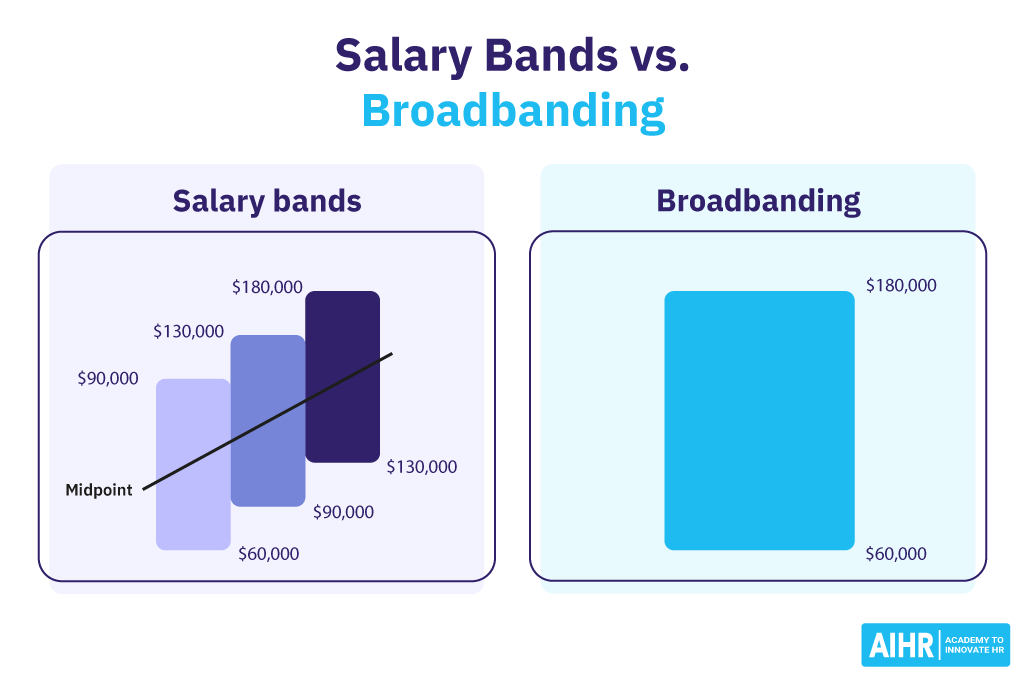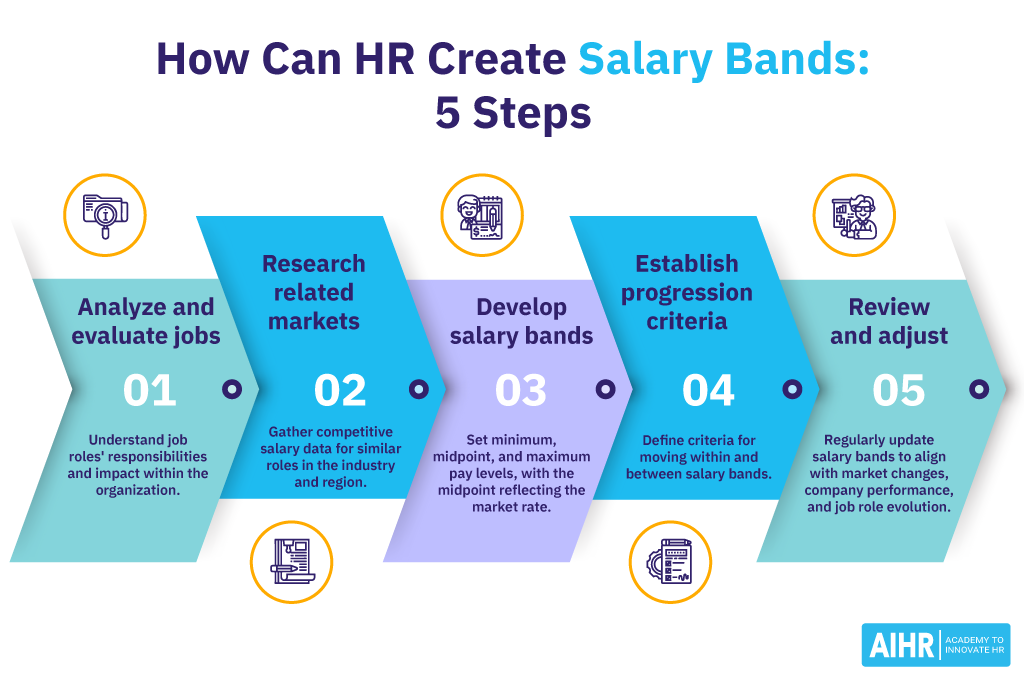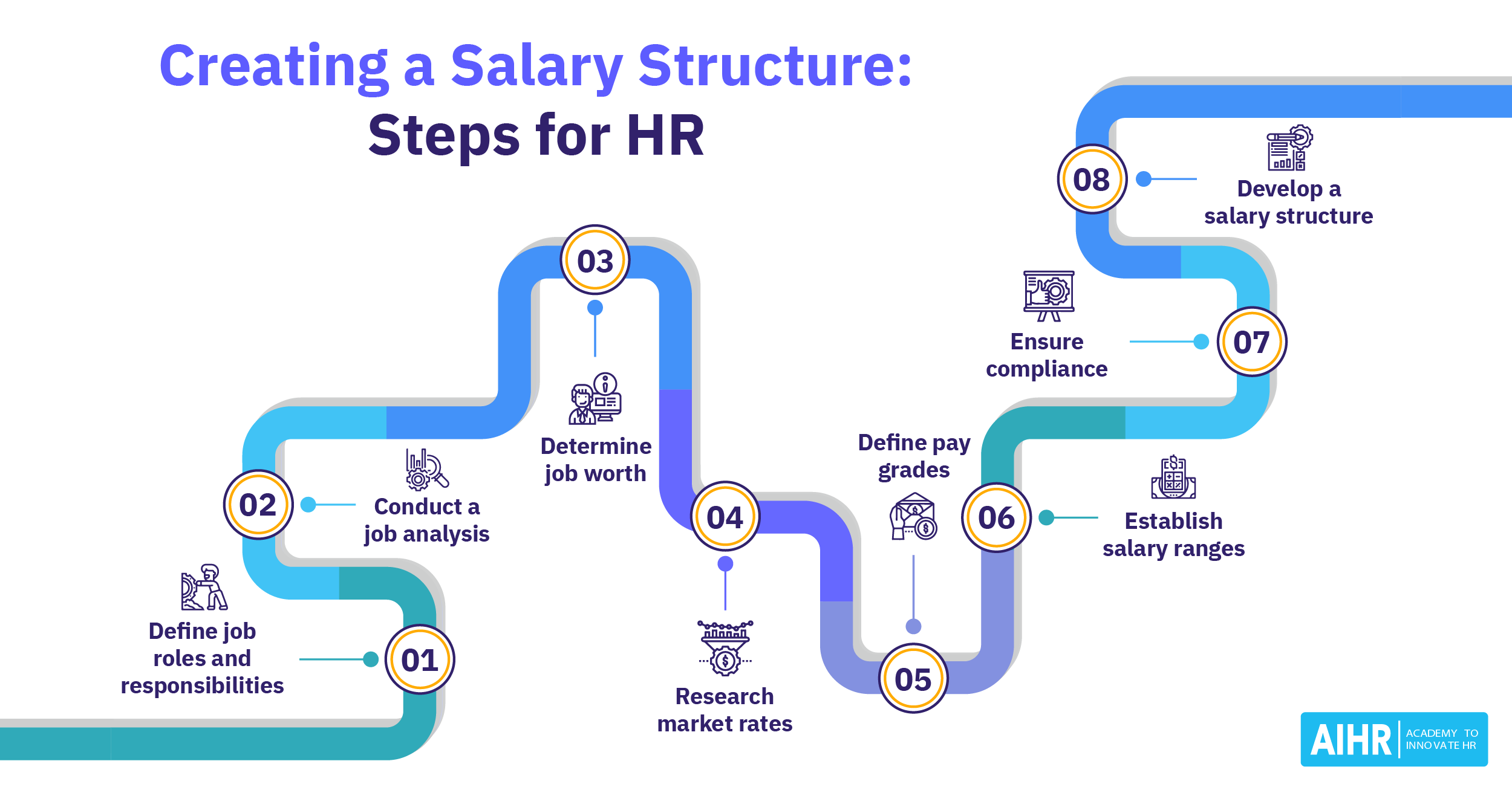Salary Bands
What are salary bands?
Salary bands, also known as pay bands, are ranges of salaries established for specific job roles or levels within an organization. They provide a structured framework for compensating employees based on their position, skills, experience, and market value.
Each band typically includes a minimum, midpoint, and maximum salary:
- Minimum: The lowest amount the company is willing to pay for the role, often for fresh graduates or less experienced employees.
- Midpoint: The market average or target pay for the role, reflecting where fully competent employees are typically compensated.
- Maximum: The highest amount the company is willing to pay, often reserved for highly experienced or exceptional employees.
Salary bands ensure internal equity, maintain competitiveness in the job market, and provide transparency and consistency in compensation practices. They can also guide discussions about pay increases, promotions, or inflation adjustments.
Salary bands examples
Here is an example of salary bands for a software developer position:
| Salary band | Level | Low range | Mid range | High range |
| Band 1 | Entry-level | $60,000 | $75,000 | $90,000 |
| Band 2 | Mid-level | $90,000 | $110,000 | $130,000 |
| Band 3 | Senior-level | $130,000 | $150,000 | $180,000 |
| Band 4 | Lead/Principal | $180,000 | $190,000 | $210,000+ |
An example of broadbanding
Unlike traditional salary band structures, a broadbanding structure consolidates multiple grades into fewer, broader bands. Here’s an example of broadbanding:
In an IT department’s broadbanding model, all roles from help desk support to chief technology officer are grouped into a single “IT” band. This approach aims to streamline compensation and encourage career progression within the IT field.
If the median salary for the band is set at $120,000, with a salary range from 75% to 150% of the median, this would establish the minimum salary at $60,000 and the range maximum at $180,000.

Advantages and disadvantages of using salary bands
Here are some of the key advantages of using salary bands:
- Promoting pay equity: Salary bands help standardize pay for positions of similar value and responsibility within the organization, which promotes fairness and equity.
- Simplified negotiation process: Clear pay ranges make salary negotiation more straightforward. Employers have a predefined range for each position, reducing the time and complexity involved in negotiating compensation.
- Market competitiveness: Employers can ensure their compensation packages remain competitive by regularly reviewing and adjusting salary bands based on market trends and benchmarks.
- Facilitating career progression: Defined bands can help illustrate potential career progression within the organization, showing employees how their pay could increase as they move up to higher-level positions.
- Improved recruitment: Offering competitive and transparent salary pay bands can make an organization more attractive to potential employees. According to a LinkedIn survey, 91% of US-based job seekers indicated that seeing salary ranges in job postings would influence their decision to submit an application.
Some disadvantages of salary bands are:
- Complex implementation: Developing and maintaining pay bands requires regular market research, analysis, and updates, which can be time-consuming and resource-intensive.
- Potential for pay compression: Employees with similar roles may cluster near the band maximum, narrowing the pay gap between new hires and experienced staff, which could demotivate longer-tenured employees.
- Difficulty in customization: Roles that don’t fit neatly into established bands may require exceptions, complicating the system.
- Employee dissatisfaction: If employees perceive they are stuck at the top of a band without room for further raises, it can lead to frustration.
With AIHR’s Compensation & Benefits Certificate Program, you’ll gain the expertise to design and manage salary bands aligned with organizational goals. Learn to use data-driven strategies to address pay equity, ensure market competitiveness, and create transparent compensation practices that drive employee satisfaction and retention.
How HR can create salary bands in 5 steps
Creating salary bands within an organization involves a structured approach to ensure fair and competitive compensation practices. Here’s a step-by-step process to follow:
- Step 1: Analyze and evaluate jobs. Begin by thoroughly analyzing job roles within the organization to understand their responsibilities, requirements, and impact on organizational structure.
- Step 2: Research related markets. Use market data to understand competitive salary ranges for similar roles in your industry and region. Sources can include salary surveys, industry reports, and online salary databases.
- Step 3: Develop salary bands. Create salary pay bands with a minimum, midpoint, and maximum pay. The midpoint typically reflects the market rate for the role.
- Minimum: The entry point for new hires with basic qualifications.
- Midpoint: Reflects the market average or the salary for a fully proficient individual in the role.
- Maximum: The top end of the range, often for top performers or highly experienced individuals.
- Step 4: Establish progression criteria. Define clear criteria for progression within and between pay bands based on factors like experience, performance, and skill acquisition.
- Step 5: Review and adjust. Regularly review and adjust the salary bands to reflect changes in the market conditions, the company’s financial performance, and changes in job roles or responsibilities.

Salary bands vs. pay scales
Salary bands and pay scales differ in structure and flexibility. Salary bands define a range (minimum, midpoint, maximum) for specific roles or levels, allowing variation based on skills, experience, and market trends. Common in private sectors, they are flexible, updated regularly, and often tied to performance or negotiation. They offer competitive compensation but leave room for ambiguity.
Pay scales, on the other hand, follow a fixed, step-based structure with progression tied to tenure or qualifications. Used widely in public sectors and unions, they prioritize uniformity, transparency, and predictability. While pay scales ensure consistency, they lack the adaptability of pay bands, which are better suited for dynamic or competitive environments requiring market alignment.
HR tip
Conduct regular reviews and updates of salary bands to ensure they remain competitive and fair. This not only helps retain employees but also attracts new talent by demonstrating the organization’s commitment to fair and competitive compensation practices.
FAQ
Salary bands can ensure fair and competitive compensation practices within an organization. They help standardize pay rates, promote equity, and provide clear paths for career progression.
Salary bands are calculated by analyzing job evaluations, market pay rates, and the organization’s compensation strategy. This involves assessing the relative value of each role within the company and its competitive market rate, considering factors like required qualifications, experience, and skills.









